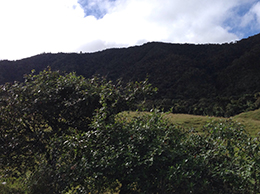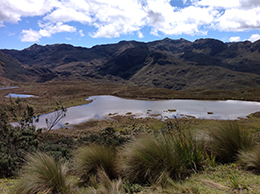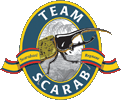.
| .... |
| . |
| JANUARY 2017 |
| |
 |
Podocarpus National Park, Zamora Sector, January 2017.
Photo by BCR. |
| |
| |
 |
Aura Paucar-Cabrera and Ron Cave, Podocarpus National Park, Zamora Sector, January 2017. Photo by BCR. |
| |
|
|
With a grant received in late 2016 from the Committee for Exploration of the National Geographic Society, an entomology expedition was conducted to Ecuador in January 2017 in furtherance of our new project to conduct a biotic survey and inventory of all of the species in the scarab subfamily Dynastinae (commonly referred to as rhinoceros beetles, although most are small and lack horns). Our purpose was to observe and collect beetles in the field and to authoritatively identify and database the holdings of scarabs in the principal research collections in Quito. This research project will discover and document the species-level diversity of dynastine scarab beetles, their spatial and temporal distributions, habitat preferences, and it will make this information available for studies in biodiversity, ecology, conservation, and applied agriculture. |
 |
 |
Lighting near Catamayo, January 2017.
Photo by RDC. |
Podocarpus National Park, Zamora Sector,
January 2017. Photo by RDC. |
| |
|
 |
 |
Golofa eacus Burmeister at Rumi Wilco near
Vilcabamba, January 2017. Photo by RDC. |
Brett Ratcliffe sorting and cleaning the night’s catch,
January 2017. Photo by RDC. |
|
| |
| __________________________________________________________________________________ |
| |
| JUNE 2017 |
 |
El Cajas National Park, Azuay, June 2017.
Photo by APC. |
|
|
In June 2017, Aura Paucar-Cabrera conducted a collecting trip to Azuay and Loja provinces for The Dynastinae of Ecuador project. Collecting methods consisted of a light trap, foliage gleaning, and searching in tree stumps and logs. In Azuay Province, she collected at El Cajas National Park (paramo, 3,600 m), Bosque Protector Aguarongo (scrubland, 3,000 m), and Rancho Alegre (grassland, 2600 m). In Loja Province, she collected at Saraguro (grassland, 2,960 m) and Bosque Protector Washapamba (wet montane forest, 2,800 m). New locality records were obtained for several dynastine species. |
 |
 |
Bosque Protector Washapamba, Saraguro, June 2017.
Photo by APC. |
El Cajas National Park, Azuay,
June 2017.
Photo by APC. |
| |
. |
|
| |
| ______________________________________________________________________________________ |
NOVEMBER 2017 |
| |

Bosque Ecológico Arenillas, November 2017.
Photo by APC.
|
.... |
In November 2017, Aura Paucar-Cabrera collected in El Oro, a province located in the southern coast of Ecuador. She visited Piñas, Moromoro, Buenaventura Reserve, Bosque Ecológico Arenillas, Puyango, Chacra, Santa Rosa, and Machala.
The ecosystems visited were dry deciduous forests and montane low evergreen forests, from sea level to 1300 m. Collecting methods were light trap, foliage gleaning, searching in tree stumps and logs, and manual collecting near public lights in urban areas. New locality records were reported for cyclocephalines. |
| |
| |
| ______________________________________________________________________________________ |
JANUARY 2018 |
| |

Río Tiputini, near Yasuní Scientific Station, January 2018.
Photo by APC. |
|

Yasuní National Park, January 2018
Photo by APC. |
| |
In January 2018, Aura Paucar-Cabrera traveled to Orellana province to collect at Yasuní National Park, a highly diverse rainforest located in the greater Amazonian area of eastern Ecuador. The methods used for collecting were light trap, foliage gleaning, and searching in tree stumps and logs. During the visit, the weather was cold and with intense rain at dusk. Despite the weather conditions, she was able to collect Cyclocephalini and Oryctini and other scarabs such as passalids, melolonthines, and rutelines (Anomalini, Geniatini, and Rutelini). The staff at the Yasuní Scientific Station of the Pontificia Universidad Católica del Ecuador were very collaborative and helpful, thus making the trip a success. |
| |
| |
| _____________________________________________________________________________________ |
MARCH 2018 |
| |

Night's catch at Imbabura, March 2018.
Photo by RDC.

Ron Cave sorting the light trap catch, Imbabura,
March 2018.
Photo by APC.
|
|
In March 2018, the team collected in three provinces in Ecuador: Carchi, Esmeraldas, Imbabura, and Pichincha.
In Esmeraldas they visited the Chocó region at the Chocó Lodge - Canandé Reserve. This reserve has a rich and forest where Cyclocephalini were most abundant, and Oryctini, Phileurini and Dynastini were also collected.
In Imbabura, the team collected near Lita at Finca Agroturística Los Robles and at El Carmen de Santa Cecilia. In Carchi, they collected by Río Baboso. These three sites are adjacent to each other, and the area is diverse and entomologically unexplored.
In Pichincha they collected in Pacto (part of the Andean Chocó), Mindo, and Quito. Cyclocephalini and Oryctini were collected in these areas. |
| |
...........
..............Night collecting with a curious visitor at Pacto,
..............Pichincha,March 2018
..............Photo by RDC. |
|

Aura Paucar-Cabrera cieaning the night's catch at Imbabura, Los Robles, March 2018
Photo by RDC.
|
| |
| |
| |
|
.... |
. |



